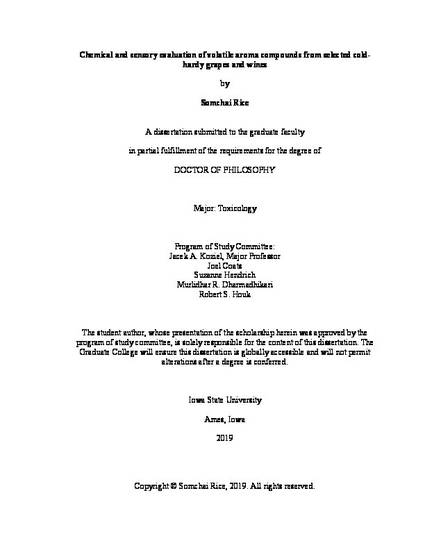
Hybrid wine grape cultivars such as St. Croix (E.S. 283 x E.S. 193), Brianna
(‘Kay Gray’ x E.S. 2-12-13), Frontenac (‘Landot 4511’ x University of Minnesota 89),
La Crescent (‘St. Pepin’ x E.S. 6-8-25), Frontenac gris (single bud sport cane from
‘Frontenac’), Marquette (MN 1094 x Ravat 262) have been developed to be cold-hardy
and disease-resistant in order to thrive in the cold climates such as the upper Midwest.
Grape growers, area of grape production, wineries, and wine production has been
increasing since the early 2000. The Iowa wine industry generated a $420 million (USD)
economic impact in 2012. Cold-climate winemakers will encounter difficulties otherwise
not encountered in areas where vinifera thrive. These struggles include high titratable
acidity and low tannins, resulting in the perceptions of tartness and a lack of body and
mouthfeel. Data about aroma profiles from volatile organic compounds of these grapes
and wines are also lacking. To investigate the phenolic content of Marquette, Frontenac
and St. Croix grape skins and seeds, at veraison and harvest, pigments and anthocyanins
were exhaustively extracted, assayed by protein precipitation and bisulfite bleaching, and
analyzed by spectrophotometer. Total tannins (from skins and seeds) decreased from
veraison to harvest (0.62 mg catechin equivalents or CE per berry to 0.30 mg CE/berry).
Monomeric pigments accounted for over 50% of the total color at pH 4.9. Short and long
polymeric pigments accounted for less than 25% of the total color at pH 4.9. To
investigate the volatile organic compounds emitted in-vivo from Frontenac, Marquette,
St. Croix, and La Crescent during ripening, two novel SPME sampling devices were
developed and metabolites were analyzed by GC-MS. PCA analysis of these volatile
metabolites accounted for 26.8-79.9 percent of the variability, and a comprehensive
summary of these metabolites was reported. To investigate the effects of harvest time on
aroma profile of wines, berries of Marquette, Frontenac, Frontenac gris and Brianna were
harvested at different time points and research wines were made. Research wines were
analyzed by an automated headspace SPME-GCMS-olfactometry method, and a
comprehensive summary of these volatile organic compounds was reported.
Available at: http://works.bepress.com/somchai_rice/16/
